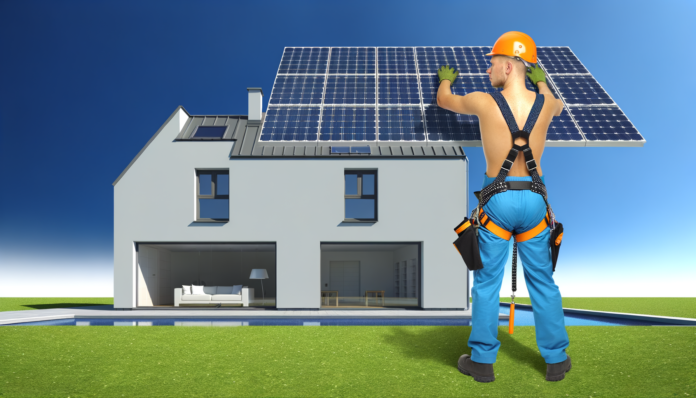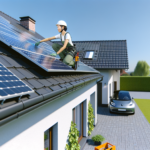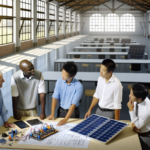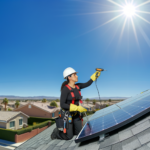Introduction to Solar Panels
Benefits of Solar Energy
Solar energy offers numerous advantages that make it an attractive option for homeowners. Here are some key benefits:
- Cost Savings: By generating your own electricity, you can significantly reduce or even eliminate your monthly utility bills.
- Environmental Impact: Solar energy is a clean, renewable resource that reduces your carbon footprint and helps combat climate change.
- Energy Independence: With solar panels, you become less reliant on the grid and more resilient to power outages.
- Increased Property Value: Homes equipped with solar energy systems often have higher property values and are more attractive to buyers.
- Government Incentives: Various federal, state, and local incentives can help offset the initial cost of installing solar panels.
Types of Solar Panels
There are several types of solar panels available, each with its own set of characteristics and advantages:
- Monocrystalline Solar Panels: These panels are made from a single crystal structure, offering high efficiency and a sleek appearance. They are ideal for homes with limited roof space.
- Polycrystalline Solar Panels: Made from multiple silicon crystals, these panels are generally less expensive but slightly less efficient than monocrystalline panels. They are a good option for larger roof areas.
- Thin-Film Solar Panels: These panels are lightweight and flexible, making them suitable for unconventional surfaces. However, they are less efficient and may require more space to generate the same amount of electricity as crystalline panels.
- Bifacial Solar Panels: These panels can capture sunlight from both sides, increasing their efficiency. They are often used in ground-mounted systems or areas with reflective surfaces.
How Solar Panels Work
Understanding how solar panels work can help you appreciate the technology behind them:
Solar panels are composed of photovoltaic (PV) cells, which convert sunlight into electricity. Here’s a step-by-step breakdown of the process:
- Photon Absorption: When sunlight hits the PV cells, photons (light particles) are absorbed by the semiconductor material, usually silicon.
- Electron Excitation: The absorbed photons excite electrons in the silicon, causing them to move and create an electric current.
- Electric Field Creation: The PV cells have an electric field that directs the flow of these excited electrons, generating a direct current (DC).
- Inverter Conversion: The DC electricity is then sent to an inverter, which converts it into alternating current (AC) electricity, the type used in most homes.
- Power Distribution: The AC electricity is distributed throughout your home to power your appliances, and any excess energy can be sent back to the grid or stored in batteries for later use.
By harnessing the power of the sun, solar panels provide a sustainable and efficient way to generate electricity for your home.
Planning Your Solar Panel Installation
Assessing Your Energy Needs
Before diving into the installation process, it’s crucial to understand your household’s energy requirements. Start by reviewing your electricity bills from the past year to determine your average monthly and annual energy consumption. This will help you estimate the size of the solar panel system you need.
Consider whether you want your solar system to cover all or just a portion of your energy needs. If you plan to expand your home or add energy-intensive appliances in the future, factor in those potential increases in energy consumption. Online solar calculators can be a helpful tool in this assessment, providing a quick estimate of the number of panels required based on your energy usage.
Evaluating Your Location
The efficiency of your solar panels largely depends on your location and the physical characteristics of your installation site. Here are some key factors to consider:
- Sunlight Exposure: Ensure your roof or installation site receives ample sunlight throughout the day. South-facing roofs are ideal in the Northern Hemisphere, while north-facing roofs are better in the Southern Hemisphere.
- Shading: Check for any potential obstructions like trees, buildings, or chimneys that could cast shadows on your panels. Even partial shading can significantly reduce the efficiency of your solar system.
- Roof Condition: Inspect your roof to ensure it is in good condition and can support the weight of the solar panels. If your roof needs repairs or replacement, address these issues before installing the panels.
- Local Climate: Consider the weather patterns in your area. Regions with frequent snow, rain, or cloudy days may require more panels to meet your energy needs.
Choosing the Right Solar Panel System
Selecting the appropriate solar panel system involves several considerations:
- Panel Type: There are three main types of solar panels: monocrystalline, polycrystalline, and thin-film. Monocrystalline panels are the most efficient and durable but also the most expensive. Polycrystalline panels are less efficient but more affordable. Thin-film panels are the least efficient but are lightweight and flexible.
- System Size: Based on your energy needs and available installation space, determine the number of panels required. Keep in mind that higher efficiency panels may allow you to install fewer panels to meet your energy goals.
- Inverter Type: Choose between string inverters, microinverters, and power optimizers. String inverters are cost-effective but less efficient in shaded conditions. Microinverters and power optimizers offer better performance in partial shading and allow for individual panel monitoring.
- Battery Storage: If you want to store excess energy for use during nighttime or cloudy days, consider adding a battery storage system. This can increase your energy independence but will also add to the overall cost.
Budgeting for Your Installation
Installing a solar panel system is a significant investment, so it’s essential to budget carefully. Here are some cost factors to consider:
- Equipment Costs: This includes the cost of solar panels, inverters, mounting hardware, and any additional components like batteries or monitoring systems.
- Installation Costs: If you choose to hire professionals, labor costs will be a significant part of your budget. DIY installations can save money but may require purchasing or renting specialized tools and safety equipment.
- Permits and Inspections: Check local regulations for any required permits and inspection fees. These costs can vary widely depending on your location.
- Incentives and Rebates: Research available federal, state, and local incentives that can offset the initial costs. Tax credits, rebates, and net metering programs can significantly reduce your out-of-pocket expenses.
By carefully planning and considering these factors, you can ensure a successful and cost-effective solar panel installation that meets your energy needs and maximizes your investment.
Gathering Necessary Tools and Materials
Essential Tools
Before you begin the installation of your solar panels, it’s crucial to gather all the necessary tools. Having the right tools on hand will make the process smoother and more efficient. Here is a list of essential tools you will need:
- Drill and Drill Bits: For making holes in the mounting surface and securing the panels.
- Screwdrivers: Both flathead and Phillips for various screws and bolts.
- Wrenches and Socket Set: For tightening bolts and nuts.
- Wire Strippers: To strip the insulation from electrical wires.
- Multimeter: To measure voltage, current, and resistance, ensuring proper electrical connections.
- Measuring Tape: For accurate measurements during the installation process.
- Level: To ensure the panels are mounted evenly.
- Caulking Gun: For sealing any gaps to prevent water ingress.
- Ladder: To safely access the roof.
Required Materials
In addition to tools, you will need specific materials to complete your solar panel installation. These materials are essential for the structural and electrical components of the system:
- Solar Panels: The primary component that captures sunlight and converts it into electricity.
- Mounting Hardware: Includes brackets, rails, and screws to secure the panels to your roof.
- Inverter: Converts the direct current (DC) produced by the panels into alternating current (AC) for home use.
- Batteries (Optional): For storing excess energy generated by the panels.
- Charge Controller: Regulates the voltage and current coming from the solar panels to the batteries.
- Wiring and Connectors: For electrical connections between panels, inverters, and the home’s electrical system.
- Conduit: Protects electrical wiring from the elements.
- Roof Flashing: To prevent water leaks where the mounting hardware penetrates the roof.
- Grounding Equipment: Ensures the system is safely grounded to prevent electrical hazards.
Safety Equipment
Safety should be your top priority when installing solar panels. Proper safety equipment will protect you from potential hazards and ensure a safe working environment:
- Safety Harness: Essential for preventing falls when working on the roof.
- Hard Hat: Protects your head from falling objects and accidental bumps.
- Safety Glasses: Shields your eyes from debris and electrical sparks.
- Gloves: Protects your hands from sharp edges and electrical components.
- Non-Slip Boots: Provides better traction and stability on the roof.
- First Aid Kit: For treating minor injuries that may occur during installation.
- Fire Extinguisher: In case of electrical fires.
By ensuring you have all the essential tools, required materials, and safety equipment, you can proceed with your solar panel installation confidently and efficiently. Proper preparation is key to a successful and safe installation process.
Preparing Your Installation Site
Site Inspection and Preparation
Before you begin installing your solar panels, it’s crucial to conduct a thorough site inspection and preparation. This step ensures that your installation will be safe, efficient, and effective.
1. **Roof Condition**: Inspect your roof to ensure it is in good condition and can support the weight of the solar panels. Look for any signs of damage or wear that might need repair before installation.
2. **Sun Exposure**: Assess the amount of sunlight your roof receives throughout the day. Remove any obstructions like tree branches that could cast shadows on your panels.
3. **Structural Integrity**: Verify that your roof structure can handle the additional load. If you’re unsure, consult a structural engineer.
4. **Permits and Regulations**: Check local building codes and obtain any necessary permits. Some areas have specific regulations regarding solar panel installations.
Mounting System Installation
The mounting system is the backbone of your solar panel setup. It secures the panels to your roof and ensures they are positioned correctly to maximize sunlight exposure.
1. **Choose the Right Mounting System**: Depending on your roof type (flat, sloped, or metal), select an appropriate mounting system. Common types include flush mounts, roof-ground mounts, and pole mounts.
2. **Mark the Layout**: Use a chalk line to mark the layout of the mounting system on your roof. This will serve as a guide for where to place the mounts.
3. **Install the Mounts**: Follow the manufacturer’s instructions to install the mounts. Ensure they are securely fastened to the roof rafters to provide a stable base for the panels.
4. **Seal the Holes**: Use roofing tar or silicone caulk to seal any holes made during the installation process. This prevents water leaks and maintains the integrity of your roof.
Wiring and Electrical Setup
Proper wiring and electrical setup are essential for the safe and efficient operation of your solar panel system.
1. **Safety First**: Always prioritize safety when working with electrical components. Wear protective gear and ensure the power is turned off before starting any electrical work.
2. **Run the Conduit**: Install conduit to protect the wiring from the elements. The conduit should run from the solar panels to the inverter and then to your home’s electrical panel.
3. **Connect the Panels**: Wire the solar panels in series or parallel, depending on your system design. Use appropriate connectors and ensure all connections are secure.
4. **Install the Inverter**: The inverter converts the direct current (DC) produced by the solar panels into alternating current (AC) used by your home. Mount the inverter close to your main electrical panel for easy access.
5. **Grounding**: Properly ground your system to protect against electrical faults. Follow local electrical codes and manufacturer guidelines for grounding procedures.
6. **Final Connections**: Connect the inverter to your home’s electrical panel. If you’re unsure about this step, consult a licensed electrician to ensure everything is done correctly and safely.
By carefully preparing your installation site, installing a robust mounting system, and setting up the wiring and electrical components correctly, you’ll lay a solid foundation for a successful solar panel installation.
Installing the Solar Panels
Mounting the Panels
Mounting your solar panels is a critical step that ensures they are securely attached and optimally positioned to capture sunlight. Begin by installing the racking system, which serves as the foundation for your panels. Follow the manufacturer’s instructions to attach the racking system to your roof or ground mount. Use a chalk line to mark where the racking will be placed, ensuring it is aligned correctly. Secure the racking with bolts and screws, and seal any roof penetrations with roofing tar or silicone caulk to prevent leaks.
Once the racking system is in place, position the solar panels on the racks. Use the supplied clamps to secure each panel, making sure they are tightly fastened to withstand wind and other weather conditions. Double-check the alignment and tilt angle of the panels to maximize sunlight exposure.
Connecting the Panels
After mounting the panels, the next step is to connect them electrically. Solar panels are typically connected in series or parallel configurations, depending on your system’s design. In a series connection, the positive terminal of one panel connects to the negative terminal of the next, increasing the voltage. In a parallel connection, all positive terminals connect together, and all negative terminals connect together, increasing the current.
Use appropriate wiring and connectors to link the panels. Ensure all connections are secure and weatherproof. It’s crucial to follow the wiring diagram provided by the manufacturer to avoid any mistakes. Once connected, route the wires to the inverter location, using conduit to protect the wiring from environmental damage.
Inverter Installation
The inverter is a vital component that converts the direct current (DC) produced by the solar panels into alternating current (AC) used by your home. Choose a suitable location for the inverter, preferably close to your main electrical panel and in a cool, shaded area to prevent overheating.
Mount the inverter on a wall or other stable surface, following the manufacturer’s installation guidelines. Connect the DC input from the solar panels to the inverter, ensuring the polarity is correct. Next, connect the AC output of the inverter to your home’s electrical system. This usually involves wiring the inverter to a dedicated circuit breaker in your main electrical panel. Make sure all connections are tight and secure.
Battery Storage Setup
If your solar system includes battery storage, this step is essential for storing excess energy generated during the day for use at night or during power outages. Begin by selecting a suitable location for the battery bank, ideally in a cool, dry, and well-ventilated area.
Install the batteries according to the manufacturer’s instructions, ensuring they are securely mounted and properly ventilated. Connect the batteries in series or parallel, depending on your system’s voltage and capacity requirements. Use appropriate battery cables and connectors to link the batteries together.
Next, connect the battery bank to the inverter or charge controller, following the wiring diagram provided by the manufacturer. Ensure all connections are secure and double-check the polarity to avoid damaging the batteries or other components. Finally, configure the charge controller settings to match your battery specifications, ensuring optimal charging and discharging cycles.
By carefully following these steps, you can successfully install your solar panels and set up a reliable, efficient solar energy system for your home.
Testing and Maintenance
Initial System Testing
Once your solar panel installation is complete, the first crucial step is to conduct an initial system test. This ensures that everything is functioning correctly and safely. Here’s a step-by-step guide to what this involves:
1. **Inspection**: Begin with a thorough visual inspection of the entire system. Check for any visible damage or loose connections.
2. **Electrical Testing**: Use a multimeter to verify that the voltage and current levels are within the expected range. This includes checking the output from the solar panels and the input to the inverter.
3. **Inverter Check**: Ensure the inverter is properly converting DC to AC power. Most modern inverters have a display or an app that shows real-time data, including power output and system status.
4. **Grid Connection**: Confirm that the system is correctly connected to the grid and that there are no issues with the utility meter.
5. **Performance Monitoring**: Activate any monitoring systems to track the performance of your solar panels. This will help you identify any issues early on.
Regular Maintenance Tips
Maintaining your solar panel system is essential for ensuring its longevity and efficiency. Here are some regular maintenance tips:
1. **Cleaning**: Dust, dirt, and debris can accumulate on your solar panels, reducing their efficiency. Clean the panels with water and a soft brush every few months, or more frequently if you live in a dusty area.
2. **Inspection**: Regularly inspect the panels for any signs of damage, such as cracks or discoloration. Also, check the mounting system and wiring for any wear and tear.
3. **Inverter Maintenance**: Keep an eye on the inverter’s display for any error messages. Most inverters require minimal maintenance, but it’s good practice to check them periodically.
4. **Vegetation Control**: Ensure that no trees or plants are casting shadows on your panels. Trim any overhanging branches that could obstruct sunlight.
5. **Professional Check-Up**: Schedule a professional inspection every 1-2 years to ensure that all components are in good working order.
Troubleshooting Common Issues
Even with regular maintenance, you may encounter some common issues with your solar panel system. Here’s how to troubleshoot them:
1. **Low Power Output**: If you notice a drop in power output, first check for any obstructions on the panels. Clean them if necessary. Next, inspect the inverter and wiring for any issues.
2. **Inverter Errors**: If your inverter displays an error message, refer to the user manual for troubleshooting steps. Common issues include grid faults, over-voltage, or under-voltage.
3. **No Power Generation**: If your system isn’t generating any power, check the main switch and circuit breakers. Ensure that all connections are secure and that there are no tripped breakers.
4. **Monitoring System Issues**: If your monitoring system isn’t displaying data, check the internet connection and ensure that the monitoring device is properly connected to the inverter.
5. **Hot Spots**: These are areas on the panel that are significantly hotter than others, indicating a malfunction. If you detect hot spots, contact a professional to assess and repair the issue.
By following these steps for testing and maintenance, you can ensure that your solar panel system operates efficiently and reliably for many years to come. Regular upkeep not only maximizes your energy production but also extends the lifespan of your investment.
Maximizing Your Solar Panel Efficiency
Monitoring Your System
To ensure your solar panel system operates at peak efficiency, continuous monitoring is essential. Modern solar systems often come with monitoring software that provides real-time data on energy production and system performance. Here are some key points to consider:
- Real-Time Data: Use monitoring tools to track the amount of electricity your system generates daily. This helps you identify any sudden drops in performance that could indicate issues such as shading or panel malfunctions.
- Performance Metrics: Regularly review performance metrics to ensure your system is meeting expected energy output. Compare these metrics against historical data to spot trends and anomalies.
- Alerts and Notifications: Set up alerts for any significant deviations in performance. Many monitoring systems can send notifications to your smartphone or email, allowing you to address issues promptly.
Seasonal Adjustments
Solar panel efficiency can vary with the seasons due to changes in sunlight intensity and duration. Making seasonal adjustments can help you maximize energy production throughout the year.
- Panel Angle: Adjust the tilt angle of your solar panels to capture the maximum amount of sunlight. In the winter, a steeper angle can help capture lower-angle sunlight, while a flatter angle is more effective in the summer.
- Shading Considerations: Be mindful of seasonal shading from trees or nearby structures. Trim any overhanging branches that could cast shadows on your panels during different times of the year.
- Snow and Debris Removal: In winter, snow accumulation can block sunlight. Regularly clear snow and debris from your panels to maintain optimal performance.
Upgrading Your System
As technology advances, upgrading your solar panel system can significantly enhance its efficiency and longevity. Consider the following upgrades:
- High-Efficiency Panels: If your current panels are older, upgrading to newer, high-efficiency models can increase your system’s overall output. Modern panels are designed to convert more sunlight into electricity, even in low-light conditions.
- Inverter Upgrades: Inverters play a crucial role in converting DC electricity from your panels into usable AC power. Upgrading to a more efficient inverter can reduce energy loss and improve system performance.
- Battery Storage: Adding a battery storage system allows you to store excess energy generated during the day for use at night or during cloudy periods. This not only maximizes your energy usage but also provides backup power during outages.
- Smart Home Integration: Integrate your solar system with smart home technology to optimize energy consumption. Smart thermostats, lighting, and appliances can be programmed to use solar power when it is most abundant.
By actively monitoring your system, making seasonal adjustments, and considering strategic upgrades, you can ensure that your solar panel system operates at its highest efficiency, providing you with maximum energy savings and environmental benefits.






